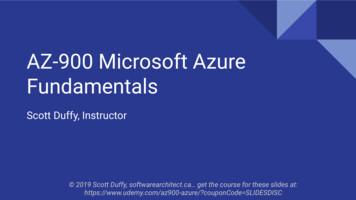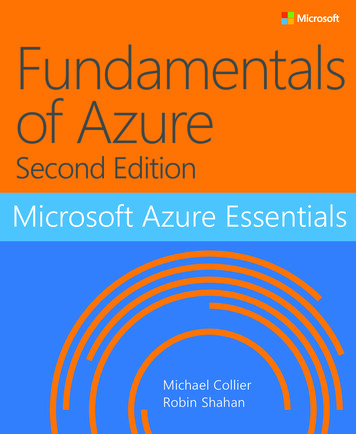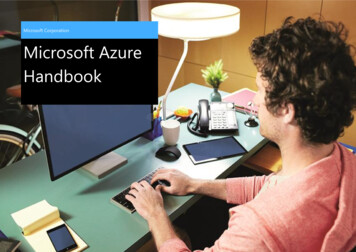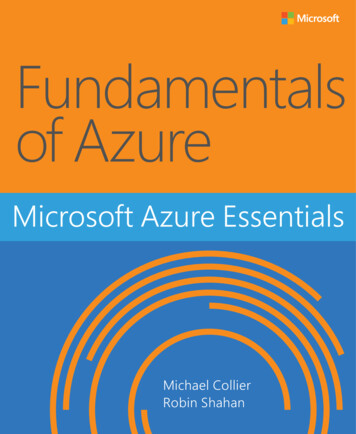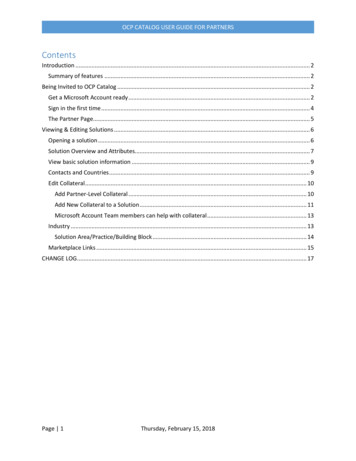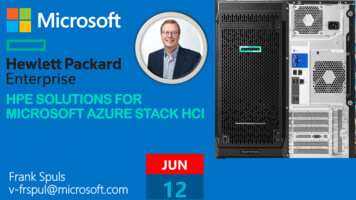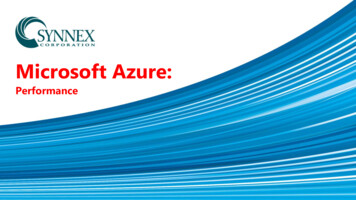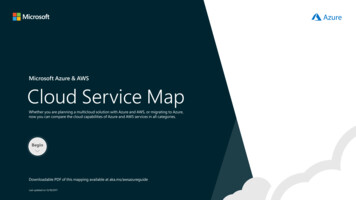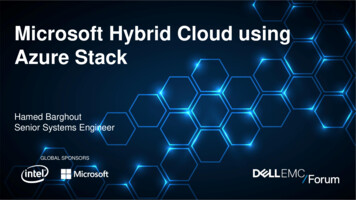
Transcription
Microsoft Azure FundamentalsV I J AY S A I N I
Course ctionCore Azure Identity servicesAbout Az-900 Certificate ExamImportant Tips
Exam AZ-900: Microsoft Azure Fundamentals Designed for candidates looking to demonstrate foundational-level knowledge of cloudservices The exam can be taken by both technical and non-technical candidates This exam doesn’t have any prerequisites. This exam measures your ability to understand the following concepts: cloud concepts; coreAzure services; security, privacy, compliance, and trust; and Azure pricing and support.
Importance of AZ-900 ExamBuild Team:Which resource group you want me to deploy the database server?Planning team:Why Azure resources are not tagged properly? This is impacting their cost calculationfor the quarter.Sales team:Use the latest version of image and build us an environment for demonstration of ourproduct to customer. Don’t forget to create guest user account for customer in azure AD.
Course StructureCloudConceptsSecurity, Privacy,Compliance and TrustCore AzureServicesPractice &earn AZ-900Azure Pricingand Support
Important The Couse structure strictly follows the examination structure Don’t Skip Quizzes We will cover lot of Azure Services at the introductory level More Theory Content in the slides Please provide your review on the course
Official Documentation https://docs.microsoft.com/en-in/azure
Thank You
Section 1 : Understand Cloud ConceptsWhat is CloudWhy CloudCloud ServiceModelsCloud DeploymentModelsCloud KeyTerminology
Computing & VirtualizationComputing:The process of utilizing computer technology to complete a task. Computing mayinvolve computer hardware and/or software, but must involve some form of a computer system.Virtualization:In computing, virtualization means to create a virtual version of a device or resource, such as a server,storage device, network or even an operating system.
What is Cloud ComputingMicrosoft Says:Cloud computing is the delivery of computing services including servers,storage, databases, networking, software, analytics, intelligence and more overthe Internet (“the cloud”) to offer faster innovation, flexible resources andeconomies of scale.AWS says:Cloud computing is the on-demand delivery of compute power, databasestorage, applications, and other IT resources through a cloud services platform viathe internet with pay-as-you-go pricing.
What is Cloud ComputingNIST Definition:Cloud computing is a model for enabling ubiquitous, convenient, on-demand network access to a sharedpool of configurable computing resources (e.g., networks, servers, storage, applications, and services) thatcan be rapidly provisioned and released with minimal management effort or service provider interaction.This cloud model is composed of five essential characteristics, three service models, and four deploymentmodels.Source: ecialpublication800-145.pdf
Cloud ComputingAs per NIST, Essential Characteristics of Cloud Computing: On-demand self-service Broad network access Resource pooling Rapid elasticity Measured service
As per NIST, Cloud ComputingDeployment Models:Service Models: Private cloud Community cloud Platform as a Public cloud Infrastructure as a Service (IaaS) Hybrid cloudSoftware as a Service (SaaS)Service (PaaS)
Advantages of cloud Cost Agility Service Quality Integration of latest technology – IOT & ML High Availability Reliability with Real time failover Disaster recovery Ease of Management
CapEx vs OpExCapital Expense (CapEx)It is a spending of money on physical infrastructure up front to create a benefit in the long term.Example: Server costs, Storage costs, Network costs, Backup and archive costs,Operating Expense (OpEx)It is an expense required for the day-to-day functioning of a business. OpEx is spending money on services or productsnow and being billed for them now. There's no upfront cost.Example: Lease/rent storage in a data center, Leasing software Operating expenses and capital expenses are treated quite differently for accounting and tax purposes. CapEx stability or OpEx flexibility
CapEx vs OpExShould I own ahouse or rent it?Should I go forpurchasing hardwareor lease it in cloud?
Azure Data Center
Azure Data Center
Economies of scaleAbility to do things more efficiently or at a lower-cost per unit when operatingat a larger scale
Disadvantages of cloud Fear of change when there’s no going back Fear of data security Fear of losing control
Test Your KnowledgeQuestion: Which term from the list below would be viewed as benefits of using cloud services?A.) Unpredictable costsB.) ElasticityC.) Local reach onlyAnswer: B
Clouds Deployment ModelsA cloud deployment model defines where your data is stored and how your customers interactwith it – how do they get to it, and where do the applications run? Private cloud Public cloud Hybrid cloud Community Cloud
Private Cloud Services offered over the Internet or over a private internal network to only select users, notthe general public. It is a cloud-based infrastructure used by stand-alone organizations. A private cloud hosting solution resides on company’s intranet or hosted data center where allof your data is protected behind a firewall. Private clouds are perfect for organizations that have high-security requirements, highmanagement demands, and availability requirements.Advantages: More flexibility, Improved security, High scalability
Public Cloud Services offered over the public Internet and available to anyone who wants to purchase them. Infrastructure is shared by multiple businesses and owned and operated by a service provider,offering fast provisioning. The cloud resources are owned and operated by a third-party cloud service provider anddelivered over the Internet. Microsoft Azure is an example of a public cloud.Advantages: Lower costs, No maintenance, Near-unlimited scalability, High reliability
Hybrid Cloud Often called “the best of both worlds”, hybrid clouds combine on-premises infrastructure, orprivate clouds, with public clouds so organizations can reap the advantages of both. Connect dedicated servers, private and public clouds to tap the power of each and runworkloads where they perform best.Advantages: Control, Flexibility, Cost-effectiveness, Ease—transitioning
Community Cloud It is a mutually shared model between organizations that belong to a particular communitysuch as banks, government organizations, or commercial enterprises. Examples include universities cooperating in certain areas of research, or police departmentswithin a county or state sharing computing resources.
Choosing a Cloud Deployment ModelTo determine cloud deployment model, we must consider: User Experience Security Responsibilities
Test your KnowledgeQuestion 1.) Suppose you have two types of applications: legacy applications that requirespecialized mainframe hardware and newer applications that can run on commodity hardware.Which cloud deployment model would be best for you?A.) Public cloudB.) Private cloudC.) Hybrid cloudAnswer: CExplanation: Hybrid cloud the benefit of both private cloud( you need for running your legacyapplication) and public cloud (which you can utilize for running you newer application)
Test your Knowledge: Understanding Cloud ConceptsQuestion 2.) Which cloud model provides the greatest degree of ownership and control?A.) PublicB.) PrivateC.) HybridAnswer: BExplanation: Private cloud models is the correct answer. Both public and hybrid clouds have aninfrastructure that is managed by another party. As such, there is less control over theinfrastructure.
Microsoft Azure FundamentalsV I J AY S A I N I
Types of Cloud Services Software as a Service (SaaS) Platform as a Service (PaaS) Infrastructure as a Service (IaaS)
Types of Cloud ServicesInfrastructure as a Service (IaaS)IaaS is the lowest level of cloud solutionThe cloud computing service provider such as Azure or AWS, manages the infrastructure, whileyou purchase, install, configure, and manage your own software—operating systems,middleware, and applications.Example: Virtual Machines, Networks, and Storage etc. on rent basis.
Types of Cloud ServicesPlatform as a Service (PaaS)With PaaS, apart from simply providing infrastructure, providers also offer a computingplatform and solution stack as a service.This service is used in developing, testing and maintaining of software. PaaS is same as IaaSbut also provides the additional tools like DBMS, BI services etc.PaaS services are mostly used by companies that need to develop, test, collaborate and deploycloud solutions for particular applicationsExamples: Azure WebApps, Salesforce, Azure SQL database
Types of Cloud ServicesSoftware as a ServiceSaaS providers provide fully functionally web-based applications on demand to customers. Theapplications are mainly targeted at business users and can include web conferencing, ERP,CRM, email, time management, project tracking among others.This service makes the users connect to the applications through the Internet on asubscription basis.Example: Office365 , Google Applications, Salesforce, Citrix
Management responsibilities
Test your Knowledge : Understanding Cloud ConceptsQuestion 1: As an end User you want to create and deploy an application in cloud as quicklyas possible without having to worry about managing the underlying infrastructure. Whichservice model is recommended for you?A.) SaaSB.) PaaSC.) IaaSAnswer: BIn PaaS model, user has to only worry about application and data and other managementresponsibilities are with Cloud Service Provider.
Test your Knowledge : Understanding Cloud ConceptsQuestion 2: You are an IT company providing a supply chain software solution which is amulti tier application and has very complex architecture. You want to be able to quicklymigrate your solution to public cloud. Which Service Model is ideal for your needs:A.) SaaSB.) PaaSC.) IaaSAnswer: CExplanation: IaaS will provides maximum flexibility and control among other service model todeploy your application quickly(lift and shift migration)
Cloud computing summaryCloud computing provides a modern alternative to the traditional on-premisesdatacenter. Public cloud vendors provide and manage all computing infrastructureand the underlying management software.These vendors provide a wide variety of cloud services. A cloud service in this casemight be a virtual machine, a web server, or cloud-hosted database engine. As acloud provider customer, you lease these cloud services on an as-needed basis.In doing so, you convert the capital expense of hardware maintenance into anoperational expense
Thank You
Section 2 : Understand core Azure servicesCore AzureArchitecturalComponentsCore ProductsAvailable in AzureSolutions Availableon AzureAzure ManagementTools
Azure ArchitectureWhat is a region?A region is a geographical area on the planet containing at least one, but potentiallymultiple datacenters that are nearby and networked together with a low-latencynetwork. Azure intelligently assigns and controls the resources within each region toensure workloads are appropriately balanced.
Azure frastructure/regions/
aA
AzureArchitecture
Availability ZoneAvailability Zones is a high-availability offering thatprotects your applications and data from datacenterfailuresTo ensure resiliency, there’s a minimum of three separatezones in all enabled regions. The physical separation ofAvailability Zones within a region protects applications anddata from datacenter ailabilityzones/az-overview
Availability Zone Availability Zones are physically separate datacenters within an Azure region. Each Availability Zone is made up of one or more datacenters equipped withindependent power, cooling, and networking. If one zone goes down, the other continues working. Availability Zones are connected through high-speed, private fiber-optic networks.
Resource GroupAn Azure resource group is a container that holds related resources for an Azuresolution.The resource group can include all the resources for the solution, or only resources thatyou want to manage as a group.
ResourceA manageable item that is available through Azure.Virtual machines, storage accounts, web apps, databases, and virtual networks areexamples of resources.
Azure ResourceManager(ARM)Azure Resource Manager isthe deployment andmanagement service forAzure.It provides a managementlayer that enables you tocreate, update, and deleteresources in your Azuresubscription.
Test your Knowledge : Understand core Azure servicesQ1. Deploying an app can be done directly to what level of physical granularity?A.) RegionB.) DatacenterC.) Server rackAnswer: A
Test your Knowledge : Understand core Azure servicesQ2. To use Azure datacenters that are made available with power, cooling, andnetworking capabilities independent from other datacenters in a region, choose aregion that supports ?A.) Geography distributionB.) Service-Level Agreements (SLAs)C.) Availability ZonesAnswer : C
Test your Knowledge : Understand core Azure servicesQ3. Application availability refers to what?A.) The service level agreement of the associated resource.B.) Application support for an availability zone.C.) The overall time that a system is functional and working.Answer: C
Azure Compute ServicesServices for hosting and running application workload Azure Virtual Machines—both Linux and Windows Virtual Machine Scale Sets App Services ( Web Apps, Mobile Apps, Logic Apps, API Apps, and Function Apps ) Azure Container Service Azure Kubernetes Service (AKS)
Virtual Machine Scale Sets
Network servicesServices for networking both within Azure and between Azure and onpremises datacenters. Azure Virtual Network Azure Load Balancer VPN Gateway Application Gateway Azure Content Delivery Network
A Simple Application ArchitectureApplication/Batch/File ServerEnd usersInternetWeb ServerDatabase Server
Virtual NetworkAn Azure Virtual Network (VNet) is a representation of your own network inthe cloud.It is a logical isolation of the Azure cloud dedicated to your subscription.You can use VNets to provision and manage virtual private networks (VPNs)
A Simple Application Architecture-VNETVirtual NetworkApplication/Batch/File ServerEnd usersInternetWeb ServerDatabase Server
A Simple Application Architecture-Multiple Web ServersVirtual NetworkApplication/Batch/ File ServerEnd usersInternetWeb ServersDatabaseServer
Load BalancerWith Azure Load Balancer, you can scale your applications and create high availability for yourservices.Azure load balancer is a layer 4 load balancer that distributes incoming traffic among healthyvirtual machine instances. Load balancers uses a hash-based distribution algorithm.We can configure the load balancer to: Load balance incoming traffic across your virtual machines. Forward traffic to and from a specific virtual machine using NAT rules.
A Simple Application Architecture-Load BalancerVirtual NetworkApplication/Batch/File ServerEnd usersInternetLoad BalancerWeb ServersDatabase Server
Virtual Network 1A Simple Application-VPN GatewayApplication/Batch/File ServerLoadBalancerWeb ServersVPNGatewayInternetEndusersVirtual Network 2VPN GatewayDatabaseServer
VPN Gateway A VPN gateway is a specific type of virtual network gateway that is used to send encryptedtraffic between an Azure virtual network and an on-premises location over the publicInternet. You can also use a VPN gateway to send encrypted traffic between Azure virtual networksover the Microsoft network. Each virtual network can have only one VPN gateway.
Azure ApplicationGatewayAzure Application Gateway isa web traffic load balancerthat enables you to managetraffic to your webapplications.you can make routingdecisions based on additionalattributes of an HTTPrequest, such as URI path orhost headers.
A Simple Application Architecture-Application GatewayVirtual NetworkApplication/Batch/File ServerEnd usersInternetApplicationGatewayWeb ServersDatabase Server
Azure CDNA content delivery network(CDN) is a distributednetwork of servers that canefficiently deliver webcontent to users.CDNs store cached contenton edge servers in point-ofpresence (POP) locations thatare close to end users, tominimize latency.
Types of data Structured Data Semi-structured Data Unstructured Data
Types of dataStructured DataStructured data is data that adheres to a schema, so all of the data has the same fields or properties.Example: A database table
Types of dataSemi-structured DataSemi-structured data doesn't fit neatly into tables, rows, and columns. Instead, semi-structured datauses tags or keys that organize and provide a hierarchy for the data.Example: JSON file, XML file
Types of dataUnstructured DataUnstructured data encompasses data that has no designated structure to it. This lack of structure alsomeans that there are no restrictions on the kinds of data it can hold.Example: email, video file, pdf
ExampleStructured dataSemi-Structured dataUn-Structured data
Azure Data ServicesAzure SQL DatabaseAzure SQL Database is a relational database as a service (DaaS) based on the latest stable version of theMicrosoft SQL Server database engine.SQL Database is a high-performance, reliable, fully managed and secure database.
Azure Database ServicesProducts available for Databases Azure SQL Database Azure Database for MySQL, Azure Database for PostgreSQL Cosmos DB Azure Database Migration service
Azure Data ServicesAzure Cosmos DBAzure Cosmos DB is a globally distributed database service. It supports schema-less data that lets youbuild highly responsive and Always On applications to support constantly changing data.You can use it to build data-driven applications and websites in the programming language of your choicewithout needing to manage infrastructure.
Azure Storage ServicesServices for storing and managing Unstructured data: Blob Storage Disk Storage File Storage Archive Storage
Azure Storage ServicesBlob Storage Azure Blob Storage is a service for storing large amounts of unstructured objectdata, such as text or binary data. No restrictions on the kinds of data it can hold You can use Blob Storage to expose data publicly to the world, or to storeapplication data privately.
Azure Storage ServicesFile Storage Azure Files offers fully managed file shares in the cloud that are accessible via theindustry standard Server Message Block (SMB) protocol. Azure file shares can be mounted concurrently by any number of cloud or onpremises VMs of Windows, Linux, and macOS at time. Typical usage scenarios would be to share files anywhere in the world, diagnosticdata, or application data sharing.
Azure Storage ServicesDisk Storage Disk storage provides disks for virtual machines, applications, and other servicesto access and use as they need A disk can be attached to only 1 VM at a time Persistent, highly-secure, cost-effective SSD option lift and shift of applications that read and write data to persistent disks
Azure Storage ServicesArchive StorageOptimized for storing data that is rarely accessed and stored for at least 180 dayswith flexible latency requirements
Azure Data ServicesBenefits of using Azure to store data Automated backup and recovery Replication across the globe Support for data analytics Encryption capabilities Storage tiers
Test Your KnowledgeQ1.) Suppose you work at a startup with limited funding. Why might you prefer Azuredata storage over an on-premises solution?A.) To ensure you run on a specific brand of hardware, which will let you form amarketing partnership with that hardware vendor.B.) The Azure pay-as-you-go billing model lets you avoid buying expensive hardware.C.) To get exact control over the location of your data store.Answer: B
Test Your KnowledgeQ2.) Which of the following situations would yield the most benefits from relocating anon-premises data store to Azure?A.) Unpredictable storage demand that increases and decreases multiple timesthroughout the year.B.) Long-term, steady growth in storage demand.C.) Consistent, unchanging storage demand.Answer: A
Test Your KnowledgeQ3.) A newly released mobile app using Azure data storage has just been mentioned bya celebrity on social media, seeing a huge spike in user volume. To meet the unexpectednew user demand, what feature of pay-as-you-go storage will be most beneficial?A.) The ability to provision and deploy new infrastructure quicklyB.) The ability to predict the service costs in advanceC.) The ability to meet compliance requirements for data storageAnswer: A
Test Your KnowledgeQ4.) You plan to map a network drive from several computers that run Windows 10 to Azure Storage. You need tocreate a storage solution in Azure for the planned mapped drive. What should you create?A.) An Azure SQL databaseB.) Virtual machine data diskC.) Files service in a storage accountD.) Blobs service in a storage accountAnswer CAn Azure SQL database can not be mapped to a VM. virtual machine data disk can be used by one VM only at a time.It cannot be used as a shared resource. Blobs storage can not be mapped/mounted to a VM. Hence The Files servicein a storage account is the best solution for mapping a network drive from several computers.
Microsoft Azure FundamentalsVijay Saini
Azure management tools Azure Portal Azure PowerShell Azure CLI Azure Cloud Shell Azure Advisor
Azure management toolsAzure PowerShellAzure CLI
Azure management toolsImportant Tips : Azure PowerShell and Azure CLI are cross platform, so you can use themon Windows, Linux and MacOS without any problem Azure Portal supports all modern browsers and is not dependent on anyOS Azure CloudShell is not dependent on any OS, It executes directly fromAzure Portal
Azuremanagementtools
Azure AdvisorAzure Advisor is a free service built into Azure that provides recommendations on high availability, security,performance, and cost. Advisor analyzes your deployed services and looks for ways to improve your environmentacross those four areas.
Azure Advisor
Test Your KnowledgeQ1.) You have an Azure environment. You need to create a new WebApp from an Android laptop. You use PowerShellin Azure Cloud Shell.Will this work?A. Yes B. NoQ2.) An Azure administrator plans to run a PowerShell script that creates Azure resources. Administrator is runningthe script from a computer that runs macOS and has PowerShell Core 6.0 installed.Does this meet the goal?A. Yes B. NoAnswer: Yes for both question
Test Your KnowledgeQ3.) Upon enabling, Azure Advisor makes your system highly available and secure.True or False?Answer: False, Azure Advisor only gives recommendation. Implementation of those is left with you.
Thank You
Microsoft Azure FundamentalsV I J AY S A I N I
SECURING NETWORKCONNECTIVITYCORE AZURE IDENTITYSERVICESSECURITY TOOLS &FEATURESMONITORING ANDREPORTING OPTIONSPRIVACY, COMPLIANCE& DATA PROTECTIONSTANDARDSAZURE GOVERNANCEMETHODOLOGIESSection 3 : Understand security, privacy,compliance, and trust
Kumbhalgarh Fort, Rajasthan, IndiaBuilt during the course of the 15th century by Rana Kumbha.The wall that surrounds the ancient fort of Kumbhalgarh is one of the best-kept secrets in India, and perhaps theworld. Protecting a massive fort that contains over 300 ancient temples, the wall was constructed half amillennium ago in tandem with Kumbhalgarh Fort itself.Information & Picture l-of-india-kumbhalgarh-fort fort-rajasthan
Securing Network Connectivity
A layered approach to securing ddos-protection-service-preview/
Azure Network SecurityGroups (NSG)NSG contains a list of security rules that allow ordeny network traffic to resources connected toAzure Virtual Networks (VNet).NSGs can be associated to subnets, individual VMs(classic), or individual network interfaces (NIC)attached to VMs
NSG
A Simple Application ArchitecturePort 80End usersInternetApplication/Batch/File ServerWeb ServerDatabase Server
Azure Application Security Groups( ASG )ASGs enable you to define fine-grained network security policies based onworkloads, centralized on applications, instead of explicit IP addresses.Provides the capability to group VMs and secure applications by filteringtraffic from trusted segments of your network.
ASG
Azure FirewallAzure Firewall is a managed, cloud-based network security service that protects your Azure Virtual Network resources.It's a fully stateful firewall as a service with built-in high availability and unrestricted cloud scalability.
DDoS AttackDistributed denial-of-service (DDoS) attack
Azure DDoS ProtectionAzure DDoS protection, combined with application design best practices, provide defense against DDoS attacks suchas Volumetric attacks, Protocol attacks, Resource (application) layer attacks
Azure DDoS ProtectionAvailable in 2 tiers:Basic:Automatically enabled as part of the Azure platform. Always-on traffic monitoring, and real-timemitigation of common network-level attacks, provide the same defenses utilized by Microsoft’s onlineservices.Standard:Provides additional mitigation capabilities over the Basic service tier that are tuned specificallyto Azure Virtual Network resources.
Azure DDoS zure-ddos-protection-service-preview/
Shared Responsibility Model
Authentication and AuthorizationAuthentication.Authentication is the process of establishing the identity of a person or service looking to accessa resource. It involves the act of challenging a party for legitimate credentials, and provides the basis for creating a security principal for identity and access control use. It establishes if they are who they say theyare.AuthorizationAuthorization is the process of establishing what level of access an authenticated person or service has. It specifies what data they're allowed to access and what they can do with it.
Azure Active DirectoryAzure Active Directory (Azure AD) is Microsoft’s cloud-based identity and accessmanagement service, which helps your employees sign in and access resources in:External resources, such as Microsoft Office 365, the Azure portal, and thousands ofother SaaS applications.Internal resources, such as apps on your corporate network and intranet, along with anycloud apps developed by your own organization.
Azure AD provides services such as: Authentication Single-Sign-On Application management Business to business (B2B) identity services Business-to-Customer (B2C) identity services Device Management
Azure Multi-Factor AuthenticationAzure Multi-Factor Authentication (MFA) provides additional security for your identitiesby requiring two or more elements for full authentication
Azure Security CenterAzure Security Center is a monitoring service that provides threat protection across allof your services both in Azure, and on-premises.Azure Security Center is a unified infrastructure security management system thatstrengthens the security posture of your data centers, and provides advanced threatprotection across your hybrid workloads in the cloud
What Azure Security Center can do Provide security recommendations based on your configurations, resources, and networks Monitor security settings across on-premises and cloud workloads Continuously monitor all your services, and perform automatic security assessments Use machine learning to detect and block malware Analyze and identify potential inbound attacks Provide just-in-time access control for ports
What Azure Security CenterAvailable in two tiersFreeLimited to assessments and recommendations of Azure resources onlyStandardfull suite of security-related services including continuous monitoring, threat detection, just-intime access control for ports, and more.
Azure Security Center -Usage scenarios1.) Use Security Center for incident response2.) Use Security Center recommendations to enhance security
Advanced Threat Protection (ATP)Azure Advanced Threat Protection (Azure ATP) is a cloud-based securitysolution that identifies, detects, and helps you investigate advancedthreats, compromised identities, and malicious insider actions directed atyour organization.Azure ATP is capable of detecting known malicious attacks and techniques,security issues, and risks against your network.
Advanced Threat Protection (ATP)Azure ATP consists of several components. Azure ATP portal (https://portal.atp.azure.com) Azure ATP sensor Azure ATP cloud service
Advanced Threat Protection (ATP) -Advantages Monitor and profile user behavior and activities Identify suspicious activities and advanced attacks Investigate alerts and user activities Protect user identities and reduce the attack surface
Azure Information Protection(AIP)A cloud-based solution that helps organizations classify and optionallyprotect documents and emails by applying label
Azure Key VaultSafeguard cryptographic keys and other secrets used by cloud apps andservicesAzure Key Vault helps solve the following problems: Secrets Management Key Management Certificate Manage
Computing & Virtualization Computing: The process of utilizing computer technology to complete a task. Computing may involve computer hardware and/or software, but must involve some form of a computer system. Virtualization: In computing, virtualization means to create a v

